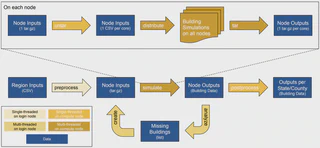A Data-Driven Approach to Nation-Scale Building Energy Modeling
Jan 13, 2022· ,,,,·
0 min read
,,,,·
0 min read
Andreas Berres
Brett C. Bass
Mark B. Adams
Eric Garrison
Joshua R. New
 High-level workflow for large-scale building simulation with AutoBEM: The bottom part of the workflow represents the overall workflow while the top portion provides more detail about the steps which run on compute nodes. The legend at the bottom contains the color-coding: all data is represented in blue, while compute steps are highlighted in different shades of yellow, depending on parallelism (darker colors indicating more parallel execution).
High-level workflow for large-scale building simulation with AutoBEM: The bottom part of the workflow represents the overall workflow while the top portion provides more detail about the steps which run on compute nodes. The legend at the bottom contains the color-coding: all data is represented in blue, while compute steps are highlighted in different shades of yellow, depending on parallelism (darker colors indicating more parallel execution).Abstract
In 2019, 125 million U.S. residential and commercial buildings consumed $412 billion in energy bills. These buildings currently consume 40% of the nation’s primary energy, 73% of electricity, 80% of energy during peak electric grid use, and responsible for 39% of greenhouse gas emissions. Urban-scale building energy modeling has grown significantly in the past decade, allowing individual campuses or communities of buildings to be modeled, simulated, and cost-effective solutions for intelligent management to be identified and implemented. While traditionally limited to individual counties and usually less than 2,000 buildings, the Automatic Building Energy Modeling (AutoBEM) soft-ware suite has been developed to process unconventional, nation-scale data sources to generate unique OpenStudio and EnergyPlus models of each building. Through the use of High Performance Computing (HPC) resources, every U.S. building has been simulated. This paper showcases the data layout, node partitioning, algorithmic approaches, and analytic results that were used to create, share, and analyze 124.4 million U.S. building models.
Type
Publication
In 2021 IEEE International Conference on Big Data (Big Data)